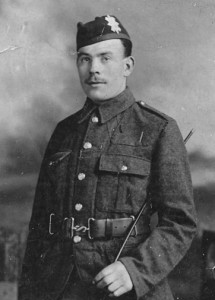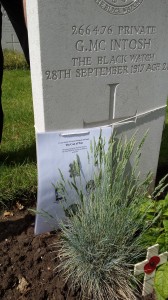George McIntosh The cost of war - continued

-
Private George McIntosh.
(266476) “D” Company 9th Battalion Black Watch. 15th Scottish Division 44th Brigade
George McIntosh was the fourth son of Joseph McIntosh and Isabella Scott and was born on the 6th March 1896 at Fingask in the parish of Kilspindie where his father was a farm worker. George’s family subsequently moved to Easter Bonhard farm in the Parish of Scone where he was educated at Kinnaird Public School. After his education finished at the age of fourteen, George was employed at Pictstonhill farm where he became a ploughman.
The war had been going on for fifteen months when he made the decision to join the army in November 1915, a few months after his 19th birthday. 1915 had been a bad year in the war and the first flush of enthusiasm had all but disappeared. Loos and Gallipoli were disastrous campaigns and, despite heavy censorship from the front, casualty lists couldn’t conceal what was really going on. The flow of volunteers was rapidly drying up and, towards the end of that year, conscription loomed large on the horizon. George McIntosh, as a young, single man, was right at the top of the list and it isn’t unreasonable to surmise he may have preferred to be known as a volunteer than as an unwilling conscript. As a volunteer, he would also have the freedom to choose his regiment and I can picture him travelling the few miles to Perth from his home to join that city’s local regiment, the Black Watch. George’s infantry training lasted twelve weeks before he was sent out to join the 6th Battalion in France in the early part of 1916. We don’t know when or for what reason but he was transferred to the 9th Battalion of the regiment which was also serving on the Western Front.
Shortly before George’s transfer, the 9th Battalion had taken part in the major offensive at Loos on the 25th September 1915. This was a particularly grim day for the British army and, in particular for the 9th. Some 30000 Scottish troops took part in the initial attack that morning. The 9th Battalion started the day with some 800 men and, in a few short hours, it had suffered 680 casualties. The wounded who could not make it back to their own lines lay where they fell until they died whether it took an hour, a day or a week. The dead could not be recovered and lay where they fell until the end of the war. It was a black day for the small parish of Scone with five members of the Black Watch from that small parish being killed at Loos on that one day.
Amongst the carnage and confusion of that day, the 9th were involved in a incident now long forgotten but which, at that time, made headlines around the world. Despite heavy casualties, the Scots managed to reach the village of Loos where they were met by Emilienne Moreau, a seventeen year old girl who, despite being under fire, pointed out to the soldiers the locations of Germans hidden amongst the houses, almost certainly preventing numerous casualties. The Scots set up a first aid post in the small shop owned by the Moreau family who assisted in looking after the many wounded despite fighting going on around them. Later that day, when the building came under attack, Emilienne took a revolver from an injured officer and opened fire on two advancing Germans, killing both. Every country needs a hero to boost morale and the teenager became a national hero. She became known as The Lady of Loos and received, amongst other awards, the Croix de Guerre from France and the Military Medal from Britain.
Because we don’t know when George transferred battalions, we can’t know exactly how he spent his time in France. However, there would have been no shortage of mud, squalor, cold, fear, fighting and death in his daily existence and let there be no doubt that, time after time during his 18 months on the Western Front, George would have had the gut wrenching experience of going “over the top” to advance over open ground into machine gun and rifle fire in an attempt to achieve some obscure objective whilst literally hundreds of his battalion comrades fell dead and wounded around him.
By July 1917, George would definitely have been in the 9th Battalion Black Watch which, on the 31st of that month, was to take part in an offensive, officially known as the 3rd Battle of Ypres but which became known more emotively as Passchendaele.
Yet again, this was to be the “big breakthrough”.
Before the attack began, constant shelling had churned up the clay soil and the heaviest rain for 30 years soon turned the ground into a quagmire of thick mud that clogged up rifles and eventually became so deep that men and horses drowned in it.
These were the conditions that George McIntosh and his battalion had to endure at dawn on the 31st July, as they advanced, once more, across the open ground of no man’s land. Progress soon ground to a halt, leaving the battalion in an exposed position and heavy losses were caused by sustained shellfire until the survivors were withdrawn late that night. I don’t know how many men took part in the action but the ranks of the 9th would have been sorely depleted before the start and the further 256 killed, wounded or missing that day, for no gain, would have reduced it to a skeleton force.
The atrocious weather resulted in the postponement of any further operations for three weeks and, during this time, the 9th received 214 replacements. Even that only managed to bring its strength to fewer than 600 men which was a far cry from the battalion’s full establishment of over 1000.
When the offensive began again three weeks later, on the 22nd August, the 9th were held back in reserve trenches but, even there, heavy shellfire caused 30 casualties. The initial attack had almost immediately descended into chaos as the leading waves had been wiped out by machine gun fire. George and his comrades were then ordered to advance into this intense fire which brought them to a standstill after 100 yards at a cost of 50 killed or wounded. The battalion dug in and remained there for two days until ordered to attack once more. This time, 200 yards were gained.
Relief arrived on the afternoon of the 26th August after which the remaining 7 officers and 245 men of the 9th Battalion Black Watch, including George McIntosh, marched out of the line in pouring rain – this was the end of their involvement in Passchendaele, with a net outcome of drastic losses and negligible gains.
The battalion moved to the Arras area where the once more severely depleted ranks were reinforced by fresh drafts. It was now into September 1917 and the regimental history described the sector as “…quiet and nothing of importance occurred for some time. After their experiences round Ypres, the peaceful atmosphere of Arras was gladly welcomed.”
How ironic was it then that George McIntosh, having endured to much and cheated death so often, was killed on the 28th of that month. The Scone Roll of Honour described the circumstances thus: “He was occupying an advanced post in part of Arras when a shell burst in the neighbourhood, taking its deadly toll of himself and six of his brave comrades.”
Pte. George McIntosh of D Company, 9th Battalion Black Watch is buried at Level Crossing Cemetery, near the town of Arras in northern France. It is hard to imagine how painful the scene would have been when my mother’s widowed granny opened the telegram from the War Office, informing her that her son had been killed. It is even harder to think of the scene as she broke the news to her four children, especially in the knowledge that her son, Thomas, was about to be conscripted.
Robert Laird, Kirkcaldy May 2014


